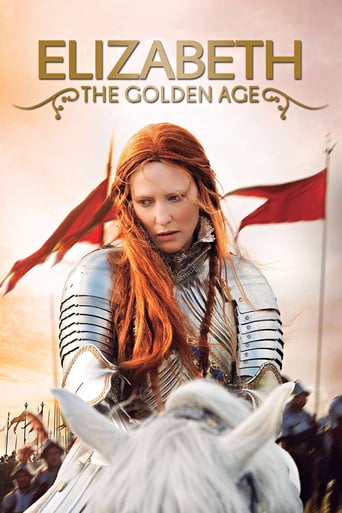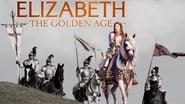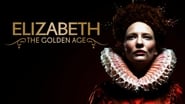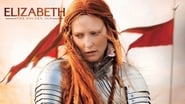Sindre Kaspersen
Indian screenwriter and director Shekhar Kapur's sixth feature film which was written by English screenwriters William Nicholson and Michael Hirst, is inspired by real events which took place in the late 16th century. It premiered in the Gala Presentations section at the 32nd Toronto International Film Festival in 2007, was shot on locations in England, Scotland and Spain and is a UK-Spain-France co- production which was produced by producers Tim Bevan, Eric Fellner and Jonathan Cavendish. It tells the story about a Queen of England and Ireland who was born in the Palace of Placentia in Greenwich, London, England in the early 1530s and who was the daughter of an English composer named Henry Tudor (1491-1547) and an English royal consort named Anne Boleyn (1501-1536).Distinctly and precisely directed by Indian filmmaker Shekhar Kapur, this quietly paced and somewhat fictional tale which is narrated mostly from the main character's point of view, draws a cinematographic portrayal of a Spanish King named Philip who aspires to make his daughter named Isabella Clara Eugenia who is an infante of Spain, the new Queen of the Kingdom of England and a Scottish Queen named Mary Stuart who is imprisoned in a castle called Fotheringhay in England. While notable for its versatile and atmospheric milieu depictions, cinematography by cinematographer Remi Adefarasin, production design by production designer Guy Hendrix Dyas and costume design by costume designer Alexandra Byrne, this dialog-driven and narrative-driven story about English history which was made seven years before an English polymath sang her words: "… think of it as a marriage refusal by me executioner … in a vertical impalement I hope you're not too tender … Mary … Queen of Scots…" depicts an abridged study of character and contains a great and timely score by composers Craig Armstrong and A.R. Rahman.This somewhat biographical, historic and terminologically spiritual character piece from the late 2000s which is set in England, Scotland and Spain in the late 16th century during the Tudor Dynasty (1485- 1603) and the Spanish Armada (1588) and where a pretender to the English throne who has legitimate claims to it thinks she knows what's best for England and the authentic Queen puts her loyalty to her nation before anything and anyone including herself, is impelled and reinforced by its cogent narrative structure, substantial character development, rhythmic continuity, soundless comment by Mary I of Scotland: "I forgive you with all my …" and the majestic acting performances by Australian actress Cate Blanchett, Australian actor Geoffrey Rush and English actress Samantha Morton. A grandiloquent narrative feature.
aceellaway2010
If, for no other reason, one rates this film on just it's visual appeal, it would score a 10. Perhaps the director is "drunk" on visual imagery. But compared to numerous pieces of mindless dross this film is just gorgeous to look upon. It does have an interesting plot and characters, and of course the excellent Cate Blanchett. Don't be put off by the negatives.. if you have the time and opportunity, put aside the negative reviews and just feast your eyes. I am not a particular fan of Clive Owen in this movie-he seems a little bland, but he performs adequately. But the center of the film is Elizabeth and as such Cate dominates-as she should.
Red_Identity
The film received mostly negative reviews when it came out, and still has to this day. To my surprise, it's adequate, although fairly average, and not that far below the quality of the original. It benefits from having a more structured plot, and the storyline is more about rising action and a climax (unlike the first). Blanchett is also quite impressive and I actually expected to think she was over the top (like I feel she sometimes is) but I think she plays it brilliantly, certainly not a nomination or performance I dismiss. Overall, it's definitely not nearly as bad as reviews would make me believe and once again the best thing about it is Blanchett.
Laakbaar
I love a good Elizabeth movie as much as anyone else. In fact, just a few days before I saw this film, I had seen a 1939 film (Private Lives of Elizabeth & Essex) starting Bette Davis and Errol Flynn. It was fascinating to be able to compare these two movies from two different eras, to see how modern cinematography has developed in its depiction of Elizabeth and the late 16th century.Perhaps unsurprisingly not much has changed with regard to Elizabeth's appearance and clothing. At least in modern movies Elizabeth is allowed to take her make-up and dress off once in a while. Even take baths.In the 1939 movie, the theme was the love affair between Elizabeth and the Earl of Essex. This 2007 movie is set somewhat earlier, but it also shows the emotional life of Elizabeth, including her feelings for Walter Raleigh.I thought that the performances in the movie were excellent. Cate Blanchett was marvellous. So was Samantha Morton and Geoffrey Rush. Clive Owen too was really good, especially at the start where he is trying to catch the queen's eye. His tale of making the crossing and reaching the new world was as gripping for the viewer as for Elizabeth. Say what you want about Clive Owen, he's good.In this movie many of the scenes were achingly beautiful. At times it was like looking at a collection of Old Masters in a museum. The lighting, colour, costumes and rich settings were all used to their best advantage.The beauty of the scenes became so striking at times, however, that the artifice kept leaping out at me. At times it was so obviously beautiful, so clearly romantic, that it seemed staged and posed.I really didn't mind this aspect though. I can't get enough of modern attempts to display medieval and renaissance life. Seriously. There must be many fascinating aspects of the period that have yet to be shown on film.OK, perhaps there was a bit too much jingoism in there. I understand that Elizabeth is a patriotic figure to the English (or at least to English filmmakers), but Elizabeth the virgin guardian angel of England? Elizabeth the warrior queen? Elizabeth the mother of her people? This is wishful thinking on the part of the director and themes that don't work for me. I suspect that English people however swell with patriotism when they see Elizabeth portrayed as a virgin-mother-warrior-angel-queen in full Renaissance finery. Even in the 1939 film the Americans did this in an old-Hollywood sort of way.The highlight of the movie for me was the execution of Mary and Elizabeth's anguish at what had happened. Morton played this brilliantly. Blanchett brought to life the doubts about it and the horror of it all. Walsingham did what he had to do, but what a mess this conflict between Protestant and Catholic really was. What did bloody Mary do to deserve this? After the movie I looked it all up on Wikipedia. Mary was actually married to Philip II of Spain. I had forgotten that fascinating detail. History could easily have gone the other way. This movie did not portray the Spanish in a way that I would consider realistic. I'm sure they were not all crazed religious zealots. No more so than English Protestants like Walsingham.There was somehow a problem with the plot or writing. The film seemed a little disjointed, jumping from one grand, beautiful, melodramatic scene to the next. I was on the director's side right up until the scene where Elizabeth exhorts her troops on horseback. That went too far. Even Cate Blanchett was unable to pull that one off.Still I enjoyed the film. It's under-rated on IMDb. I'm not sure why.






